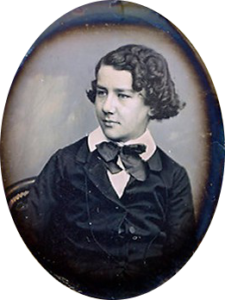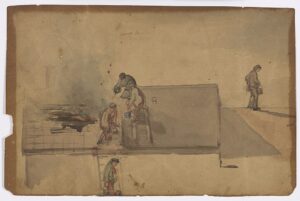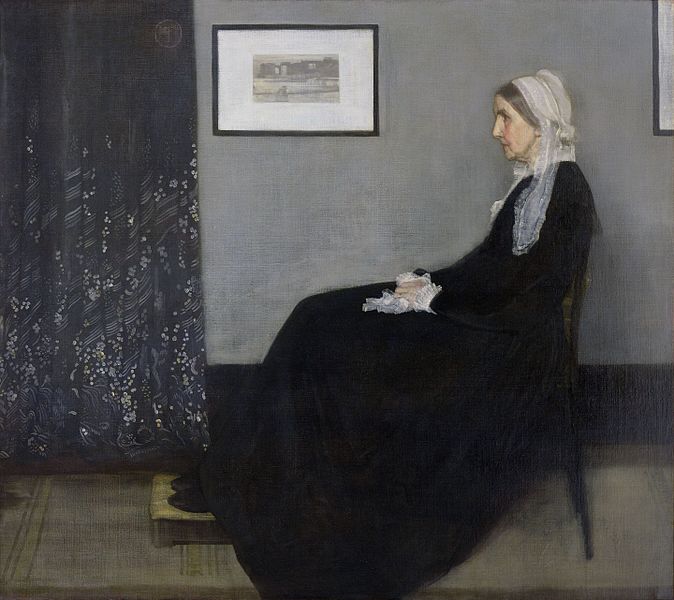Last Updated: February 12, 2025
By Christina Volpe
As one of the most well-known American realist painters of the late 19th century, James Abbott McNeill Whistler has intrigued art history enthusiasts for over a century. The first full length biography about Whistler’s life, The Life of James McNeill Whistler, includes a chapter devoted to Whistler’s “School-Days in Pomfret” and recollects how dismal the family’s financial situation was following the death of James’s father in 1849. Select drawings recovered from James’s childhood in Pomfret, Connecticut between 1849 and 1851 appear to be emotionally driven and depict aspects of daily life in the northeast Connecticut town.

James Whistler as a child (c.1847-49) – By William Edward Kilburn, Wikimedia Commons. Used through Public Domain.
James Whistler’s Childhood
Whistler spent his childhood moving throughout New England and Europe. During his childhood travels in New England, he witnessed firsthand the changing landscape of an industrializing region. For a few years between 1837 and 1839, Whistler’s family lived in Stonington, Connecticut as his father, George Whistler, worked as an engineer for the Providence and Stonington Railroad.
In 1842, the Russian Empire recruited George Whistler to engineer the country’s first railroad and the Whistler family followed. In 1849, while overseeing the construction of Russia’s first railroad between St. Petersburg and Moscow, George Whistler succumbed to cholera. After George’s death, James’s mother Anna Whistler brought her family back to Connecticut. She wrote to a friend, “Nothing but duty to my boys could give me courage to look for a home among strangers.”
Growing Up in Pomfret
Following the burial of George, Anna Whistler had an annual income of just $1,500. As she searched for a permanent home for her family she wrote to a friend, “Stonington would be my preference, above all others,” but her circumstances landed her in Pomfret.
Whistler received the latter half of his childhood education in Pomfret. With no European entertainment options available to him, Whistler settled into art. A few depict images from the artist’s favorite storybooks, but more reflect his early interest in realism, showcasing daily life in Pomfret. One particular image, A Fire in Pomfret (1851) depicts a fire being put out on top of a building, drawn as if Whistler floated from above to draw it.
After Pomfret

A Fire at Pomfret – By James Abbott McNeill Whistler, Wikimedia Commons. Used through Public Domain.
After Connecticut, Whistler spent a few years enrolled at the United States Military Academy at West Point. After the Academy dismissed him, Whistler worked for a few years at various jobs while continuing to practice his art. In 1855, Whistler moved to Europe to pursue art training in Paris.
Once overseas, he never returned to live in the United States. His mother Anna joined him in London in the 1860s and remained there until her death. Whistler once summarized his feelings for the place where he spent his adolescence by stating: “If I ever make the journey to America, I will go straight to Baltimore, then to West Point, and then sail for England again.”
Over his life, Whistler produced countless drawings, etchings, and paintings. Many pieces of Whistler’s art are currently spread across the country at museums such as the Art Institute of Chicago, the Frick Gallery in New York, and the Hill-Stead Museum in Farmington, Connecticut.
Whistler’s time in Pomfret proved that even without lessons and the community of artists he later surrounded himself with in Europe, he was still capable of producing emotionally provocative and detailed depictions of people doing everyday things. Whistler’s reflections of Pomfret convey the complexities of a child’s mind when exposed to troubles brought on by death and poverty.
Christina Volpe works as a historical consultant in archival and cultural resource management. She wrote this article while completing her MA in Public History at Central Connecticut State University.
This article has been updated, learn more about content updating on ConnecticutHistory.org here.









